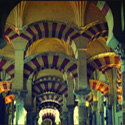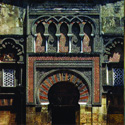Architecture

|
For centuries during the Middle
Ages, Lethaby says, what filled the minds of makers and
listeners were `Mahomet, Caliphs and Emirs, Arabs,
Turks, and Saracens who had nothing white but their teeth;
Spain, Africa, Egypt,
Persia; Cordova; Toledo
;
Seville
;
Palermo; Babylon, and Alexandria with its harbours and
ships...’'[1]
Fascination, which eventually turned to imitation; imitation
Rodinson observes, that was reinforced by the perception of the
superiority of such civilisation; a model to imitate, at least
on the cultural and scientific levels.[2]
Often the imitation hardly answering any new needs, just
satisfying old ones but according `to new modalities which bear
the mark and the prestige of the civilisation from which the
borrowing is made (the Islamic).’[3]
Eagerness for imitation by artists and architects, too, and
lasting until fairly recently as noted by Sweetman:
`Owen Jone's masterly exposition of the geometrical complexities
of Moorish patterns: or William de Morgan's patient researches
into Persian glazes… the calm and fascinated interest of
Christopher Wren, more than 100 years before the Royal pavilion,
in the relationship between `Saracenic' style of architecture
and Gothic.’[4]
How Western
Christendom
imported and adopted the superior Islamic model in arts and
architecture, culture and civilisation is looked at here. By no
means will this chapter, just as the others, claim to be
faultless or comprehensive. In the particular field addressed
here, Islamic architecture, arts, culture, and their impact,
years of work and thousands of pages will be needed to give them
their due worth. This is beyond this author. Also, many sources
will be cited in this chapter, but many good ones will be for
one reason or another missing.[5]
For a quick and informative source on Islamic art and
architecture and their impact, is advised to look at the
following site:
http://www.islamicart.com/main/architecture/impact.html
[1]
W.R. Lethaby: Medieval Architecture: in The legacy of
the Middle Ages, edited by C.G. Crump and E.F Jacob:
Oxford at the Clarendon Press, 1969 ed, pp 59-93. p. 63.
[2]
M. Rodinson: les Influences de la Civilisation Musulmane
sur la Civilisation Europeene Medievale dans les domains
d la Consommation et de la Distraction: l’Alimentation.
In Academia nazionale dei Lincei; op cit; pp
479-99; at p.482.
[3]
Ibid. p.482.
[4]
John Sweetman:
The Oriental Obsession: Cambridge University Press,
1987; p.6.
[5]
For some good works not used here, see for instance:
-E. Male: Art et artistes du Moyen Age; Paris
1927; pp. 30-88.
-G.Marcais: Manuel d’Art Musulman; Paris; 1926.
-H.Terrasse: L’Art hispano mauresque des origines au
13em siecle; Paris; 1933.
-M.Gomez Moreno: Iglesias mozarabes; Madrid;
1919.
-E. Lambert: L’Art gothique en Espagne aux 12 et 13em
siecles; Paris; 1931. |





